|
Chapter 2 -
1930 - 1939 |
|
By
this time Shropshire and Herefordshire had pooled their chess resources
as the Shropshire and Herefordshire Chess Association.
Both league and county individual competitions were organised on a zonal
basis largely determined by the bus and rail networks, which were a
key element in travel arrangements. The Northern Division included clubs
at Shrewsbury, Wellington and Whitchurch, with new clubs founded at Ironbridge (16th March 1934), and a Church
Stretton Club founded on 3rd December 1934. Meanwhile in the Southern
Division Ludlow and Bridgnorth met Herefordshire clubs based at Hereford, Lyonshall,
Leominster, Kington, and Rhos on Wye. East and West zones also featured to make
individual competition more practical. Winners of the zones met to determine
overall county champions. The league championship trophy has not survived
so details of winners are not available. Following Rev.W. Benson's win in 1930, the County Individual Championship was dominated by Frank Clayton of Wellington who won six times between 1931 and 1937, the latter shared with Rev A.P.Lacy-Hulbert who also won in 1934. In 1938 a new force emerged in the form of Lt.Col.D.E.MacNab who was the only champion from 1938 until 1947, although the war years had prevented competition between 1940 and 1945. Time controls had to be adjusted to fit in with travel timetables whilst it was not unusual for a game to be defaulted because someone had missed the train! |
||
|
|
||
Frank Clayton
- Six Times County Champion 1931 - 1937 Purely on the playing side the pre-war era was dominated by Frank Clayton, a Wellington schoolmaster whose record of six championship wins achieved over seven seasons was very impressive. He also knew how to cope with his top board opponents in county matches as you will see, for example, from the following game in which he gives the master strength MacKenzie, a former Scottish Champion, a horrible fright. He seemed quite unaffected by the occasionally bizarre conditions of play in the county championships of those days. The event used to run on a knockout basis with each round decided by the best of three games. Incredibly it seems from Lacy-Hulbert's column that it was quite usual to complete all three games at one session or even to finish games by correspondence! No doubt the very limited car ownership of those days was a major influence and the press reports make frequent reference to fast time limits being agreed upon beacause of bus times etc. Illness curtailed Frank Clayton's chess in his later years and he was president of the Shropshire Association when he died in 1952. Clayton,F - Mackenzie,A [C20] Shropshire & Herefordshire v Warwickshire Board 1, 1933 Mackenzie's opening error was uncharacteristic - he had been Scottish, Sussex and Warwickshire champion in his time - but he soon buckles down and makes the Shropshire champion work hard for his win which he just misses near the end. 1.e4 e5 2.Nf3 Nc6 3.Bb5 a6 4.Ba4 Nf6 5.Nc3 b5 6.Bb3 d6? 7.Ng5 Be6 8.Nxe6 fxe6 9.Bxe6 Nd4 10.Bb3 b4 11.Ba4+ c6 12.Ne2 Qa5 13.c3 Nb5 14.c4 Na7 15.Ng3 g6 16.0–0 Bg7 17.d3 0–0 18.f4 Nc8 19.f5 (not19Bxc6 Qc5+!) 19...Ne7 20.fxg6 hxg6 21.Bb3 Kh8 22.Bg5 Neg8 23.Qe2 Qc7 24.Rf3 Rae8 25.Raf1 a5 26.Nh1 a4 27.Bd1 (not 27 Ba4? Qa7+) 27...d5 28.Nf2 Nh7 29.Rh3 a3 30.bxa3 bxa3 31.cxd5 cxd5 32.exd5 Ngf6 33.Bxf6 Bxf6 34.Ne4 Be7 35.Rxf8+ Rxf8 36.d6 Qb6+! (36.......Bxd6? Ng5!) 37.Qe3 Bd8 38.d4 exd4 39.Qd3 Kg7 40.Bb3? (Missing the last winning chance with 40 Bc2 threatening 41 Rxh7 Kxh7 42 Ng5+ Bxg5 43 Qxg6 and mates) 40...Ng5 41.Nxg5 Bxg5 42.Rf3 Be3+ 43.Kf1 ½–½ |
||
|
Lt.Col.D.E.MacNab - Four Times
County Champion 1938 - 1947 |
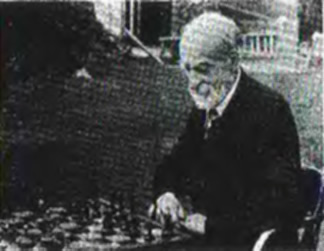 Thomas Henry Chetwynd Thomas Henry ChetwyndMenber of Bridgnorth Chess Club 1880's-1890's Member of: Hereford City Chess Club 1924-1952 Born 30 Aug 1860 Red Hill School, Old Swinford Near Stourbridge Worcester was a wonderful Poet and wrote quite a few poetry books about the Herefordshire district, died in 1957 Hereford. Employed by the Board of Customs and Excise at: Brierley Hill, Liverpool, Sheffield, Bridgnorth, Much Wenlock, Royton, London, Merthyr Tydfil, Hull & other parts of England & Scotland – many of these towns have famous Chess Clubs and he represented them in matches. Learned to play Chess when he was appointed to Bridgnorth under the tuition of Mr F. H. JOYNSON an old Shropshire stalwart. Whilst living in Much Wenlock CHETWYND played four times in simultaneous games against J. H. BLACKBURN obtaining three draws. ( Blackburn being one of the World's Greatest Players). Rev. E. E. CUNNINGTON was curate at Tuck Hill near Claverley while T. H. CHETWYND was stationed in Much Wenlock; many Games they played probably at Bridgnorth Institute Chess Club. T. H. CHETWYND also assisted in the preparation of one of CUNNINGTON'S books, “The British Chess Code” (1894) . Runner up in the Shropshire Individual County Championship c1899 losing to J. E. PARRY who afterwards played for South Manchester. In Hull he played Chess for the local club at the suggestion of R. T. R. SERGEANT a noted Service player. Also played Chess for Brynmawr, Brecon for two seasons. CHETWYND came to Hereford in 1924 Three times Individual Champion of Herefordshire & runner up on several occasions, on one of these occasions he played the redoubtable E. F. FARDON, he lost the first & seventh games and there were five draws in between. Was one of the British Team in 1000 Board Contest by Correspondence against U.S.A. (1937) obtaining a draw. CHETWYND played Sir George THOMAS (twice British Chess Champion) in 1944 at 84 years of age. He retired from competitive chess for Hereford in 1952 at age 92. Fished every corner of England. Author of: “Little Dorothy”, “A Fleeting Vision”, “Verses Grave and Gay”, “Poems For The People”, “Plain Poems” etc courtesy of Cheryl Fletcher ("he was my great uncle"} of Perth, Western Australia E.F.Fardon - T.H.Chetwynd [C20] Herefordshire Championship, 1938 The Herefordshire Championship was played as an open event each year and, unlike the Shropshire Championship at that time, the holder participated from the start. 1.e4 e5 2.Bc4 Nf6 3.Nf3 Nc6 4.Ng5 Launching the Fegatello Attack against the Two Knights Defence 4...d5 5.exd5 Nxd5 6.Nxf7 Kxf7 7.Qf3+ Ke8?? The only reasonable move here is Ke6 aiming to hang on to the extra material 8.Bxd5 Qf6 9.Bxc6+ bxc6 10.Qe2 Simply Qxf5 leaves white a safe pawn up with black's doubled pawns a millstone around his neck for the endgame. 10...Bc5 11.Nc3 Bf5 12.d3 h6 13.0–0 Kf7 14.Be3 Bb6 15.f4 Rhe8 16.fxe5 Qxe5?? 17.Ne4?? Played on move 14, 15, or 16 this would have been strong. Now however it allows black to fight back and salvage the draw. Much stronger was 17.Bxb6 axb6 18.Qxe5 Rxe5 19.d4 Rea5 20.b4 Ra3 21.Rxf5+ Kg6 22.Rf3 and white wins 17...Kg8 18.Bxb6 cxb6 19.Rad1 Bxe4 20.dxe4 Qxe4 21.Qxe4 Rxe4 22.Rd7 a5 23.Rff7 Rg4 24.Rb7 b5 25.Rfc7 Rg6 26.Rb6 Rd8 27.Rcxc6 Rd1+ 28.Kf2 Rd2+ 29.Kf3 Rgxg2 30.Rxb5 Rgf2+ 31.Ke3 Rfe2+ 32.Kf3 Rf2+ 33.Ke3 Rfe2+ 34.Kf3 Rf2+ A fine draw by the 78 year old Chetwynd against a strong opponent. ½–½ |
Ernest Groom - County President 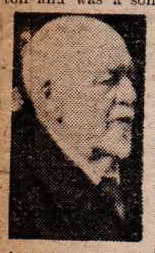 Ernest Groom of Wellington Chess Club was President of the Shropshire & Herefordshire Chess Association and, in 1926, he presented the handsome trophy which is still in use today for the county individual championship. The first winners were F.S.Smart (1928 and 1929) and Reverend W.Benson (1930). Ernest Groom of Wellington Chess Club was President of the Shropshire & Herefordshire Chess Association and, in 1926, he presented the handsome trophy which is still in use today for the county individual championship. The first winners were F.S.Smart (1928 and 1929) and Reverend W.Benson (1930).Great Britain vs United States Correspondence Match 1937 The chief interest of this game was the event in which it was played - on board 643 out of 1000! Groom,E - Krant,A [C50] 1.e4 e5 2.Nf3 Nc6 3.Bc4 Bc5 4.0–0 Nf6 5.d4 Nxd4 6.Nxe5 Ne6 7.Bxe6 fxe6 8.Nd3 Qe7 9.e5 Nd5 10.Qh5+ g6 11.Qg4 b6 12.a3 Qf8? 13.c4 Ba6 14.b4 Be7 15.b5 Bb7 16.cxd5 Bxd5 17.Nc3 Bb7 18.Ne4 Qg7 19.Nf6+ Bxf6 20.exf6 Qf7 21.Bb2 d6 22.Rfe1 Kd7 23.Rad1 1–0 Extract from Wellington Journal 26/08/1944 Late Mr.Ernest Groom, of Dothill Park Mr Ernest Groom, of Dothill Park, managing director of Messrs.R.Groom, Sons & Co.Ltd.,timber merchants, Wellington, died suddenly at the works on Tuesday morning. He had been in failing health for some time. Aged 84, he was born at Arleston and was a son of the late Mr.Richard Groom, the founder of the firm. Mr.Ernest Groom was educated at the Grove Park School, Wrexham, and then entered his father's business, of which he had been in control since the death of Mr.Richard Groom in 1892. At one time he was chairman of the Midland Home Grown Timber Merchant's Association. For a number of years he was chairman of the Girl's High School and the Boy's High School at Wellington. He was an enthusiastic chess player and was president of the Shropshire Chess Association. He was a bachelor and a member of a family of 11. Two brothers and a sister survive him. |
|
C.H. Greenhalgh - Shrewsbury Reverend W.R.Greenhalgh
- Shrewsbury |
|
E.Lupton-May
- Hereford Chess Club The top board game between Wellington and Hereford was no doubt one of the more important Shropshire league encounters and Clayton (Wellington) wins this one with an opening (Scotch Gambit) which was held in low esteem at the time. Clayton,F - Lupton-May,E [C44] - Wellington v Hereford . 1934.- Board 1 1.e4 e5 2.Nf3 Nc6 3.d4 exd4 4.c3 dxc3 5.Bc4 h6? 6.Nxc3 Bb4 7.0–0 Bxc3 8.bxc3 d6 9.Qb3 Qf6 10.Bb2 Bd7 11.Bb5 a6 12.c4 Qg6 13.Bxc6 Bxc6 14.Nh4 Qg4 15.Nf5 f6 16.f3 Qg6 17.c5 d5 18.Nd4 Ne7 19.Nxc6 bxc6 20.exd5 cxd5 21.Rfe1 Qf7 22.Qb7 0–0 23.Qxc7 Rfe8 24.Ba3 Rac8 25.Qd7 Rcd8 26.Qb7 Rc8 27.Re2 d4 28.Rae1 Nf5 1–0 by adjudication. After 29.Qxa6 Ne3 30.Qd3 white has no problems |
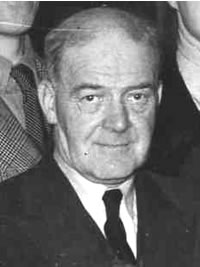 J.Jones
- Ludlow J.Jones
- LudlowJohnny Jones was a Ludlow schoolmaster who ran junior chess very ably. Like E.G.Small he was a tough man to beat, particularly at postal play, right up until the 1960's when he dropped out of serious chess. The game, played on board 17 for the county team is a rare example of a black win with the Two Knights Defence against the Fegatello Attack. Credit must go to Jones for switching quickly to the attack by 21......a5 after white had faltered. Forrester,D - Jones,J [C57] Shropshire & Herefordshire v Staffordshire, 1936 Bd.17 1.e4 e5 2.Nf3 Nc6 3.Bc4 Nf6 4.Ng5 d5 5.exd5 Nxd5?! (Jones probably knew that Na5 is best but decided to test his opponent's nerve. Technically the strongest reply is 6.d4 - but who could resist the chance of the ancient and famous "Fegatello" Attack first played in 1600 between Polerio and Domenico.) 6.Nxf7! Kxf7 7.Qf3+ Ke6 8.Nc3 Nce7 9.d4 c6 10.Bg5 Qd6 11.0–0–0 Kd7 12.Nxd5 cxd5 13.dxe5 Qe6 14.Bxd5 Nxd5 15.Rxd5+ Kc7 16.Bd8+ Kb8 17.Kb1 Be7 18.Bxe7 Qxe7 19.Qg3 Be6 20.Rd6 Qf7 21.b3 a5! 22.Rhd1 Rc8 23.Qe3 Qc7 24.R6d2 Bf5 25.Qe2? 0–1 |
|
Dr
Shubsachs - Shrewsbury Dr. Shubsachs wrote a chess column in the Shrewsbury Chronicle for a short time. He published this game from a 1934 Shropshire league clash. Despite black's rather passive opening the queen sacrifice at the end is a little gem. Jackson,J - Ferrie,J [D47] - Wellington v Shrewsbury - 1934 - Board 4 Queens Gambit - Semi Slav Defence 1.d4 d5 2.c4 dxc4 3.Nf3 e6 4.Nc3 Nf6 5.e3 c6 6.Bxc4 Nbd7 7.0–0 Be7 8.b3 Nb6 9.Bb2 Nxc4 10.bxc4 0–0 11.Ne5 Nd7 12.f4 c5 13.Ne4 Nxe5 14.dxe5 Qc7 15.Qh5 h6 16.Rf3 Rd8? 17.Rg3 Bf8 18.Nf6+ Kh8 19.Qxh6+ gxh6 20.Rg8mate 1–0 |
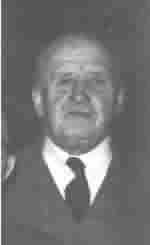 E.G,Small
- Ludlow Chess Club E.G,Small
- Ludlow Chess ClubSmall was a tough man to beat at correspondence or over the board up to the early 1960's when Ludlow Chess Club folded up. The club had been one of the strongest in the Shropshire League but when most of its members, Chesterman, Serck, Small etc reached old age there was no new blood appearing. Happily after a gap of over thirty years a new Ludlow Club has emerged. Small,E - Davies,A (Belfast)[E16] - Ludlow Congress , 1935 1.d4 Nf6 2.c4 e6 3.Nf3 b6 4.g3 Bb7 5.Bg2 Bb4+ 6.Bd2 Bxd2+ 7.Nbxd2 0–0 8.0–0 d5 9.cxd5 exd5 10.Qc2 Nbd7 11.Rac1 Rc8 12.Nb3 c5 13.dxc5 Nxc5 14.Nbd4 Nce4 15.Qd1 Rxc1 16.Qxc1 Qc8 17.Ne5 Qxc1 18.Rxc1 Rc8 19.Rxc8+ Bxc8 20.Nec6! Bb7 21.Nxa7 Nc5 22.Nab5 Nfe4 23.Kf1 Na4 24.b3 Nac3 25.Nxc3 Nxc3 26.a4 Ne4 27.Ke1 Nc5 28.Kd2 Kf8 29.f3 Ke7 30.Bf1 Ba6 31.Bg2 Bb7 32.f4 g6 33.Ke3 f5 34.h3 Kd6 35.g4 Bc8 36.gxf5 Bxf5 37.Nb5+ Kd7 38.Bxd5 Bxh3 39.Nd4 Kd6 40.Bg8 h6 41.Bh7 Bf5 42.Nxf5+ gxf5 43.Bxf5 Nxb3 44.Bc2 Nc5 45.Kf3 Ke6 46.e4 Nd7 47.Kg4 Kf6 48.Kh5 Ke6 49.Kxh6 1–0 |
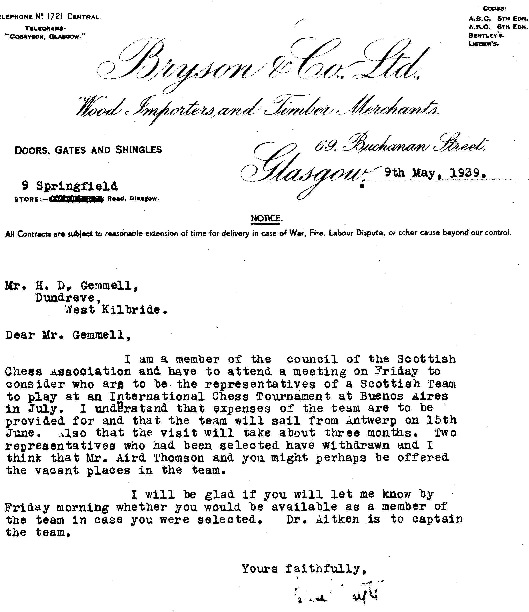 Dr H.D.Gemmell
- Shrewsbury
Dr H.D.Gemmell
- ShrewsburyDr Gemmell didn't get to Buenos Aires in 1939 because the war had broken out but he had to make a miserable choice between three months in South America or his place at medical school. Scotland still intended to go but I think, in the end, they couldn't get their act together and had to drop out. The war broke out whilst the event was on - Germany to play Poland the following day or so! That match was cancelled. I attach Dr Gemmell's letter of invitation from the Scottish C A which, initially, he wanted to accept. It is remarkable for the casual way in which he is asked to say by the end of the week if he can spend three months in Argentina. -D.Everington At the time Dr Gemmell, Scottish Junior Champion, was still living in Scotland. He later set up a medical practise in Westbury, Shropshire. See 1940's for further details. |
Annual match held at The Midland Institute,
Birmingham 27/10/1934 Warwickshire versus Shropshire and Herefordshire |
|||
| Warwickshire | Shropshire and Herefordshire | ||
| A.E.Chamberlain | 0 |
Rev.A.P.Lacy-Hulbert (L) | 1 |
| W.P.Morry | 0.5 |
F.Clayton (W) | 0.5 |
| R.A.V.Taylor | 0 |
Rev.W.R.Greenhalgh (S) | 1 |
| E.B.M.Conway | 1 |
P.G.Perry | 0 |
| A.C.Keey | 0 |
J.C.Wordsworth (H) | 1 |
| C.A.James | 0 |
E.Lupton-May (H) | 1 |
| R.L.Aldis | 0.5 |
E.Groom | 0.5 |
| W.M.Buckley | 1 |
W.H.Smith (Wh) | 0 |
| F.J.Burgoyne | 0 |
C.H.Greenhalgh (I) | 1 |
| A.Cannana | 1 |
F.W.Forrest | 0 |
| W.T.Bayliss | 1 |
E.G.Small (L) | 0 |
| H.S.Gopsill | 1 |
J.Ferrie (S) | 0 |
| B.J.Lewsley | 1 |
J.O.Jackson | 0 |
| R.H.Bridgwater | 0.5 |
T.I.Lusty (Wh) | 0.5 |
| A.T.Motchett | 0 |
L.E.Barker (L) | 1 |
| H.W.Clark | 0.5 |
T.H.Chetwynd (H) | 0.5 |
| J.C.Devonshire | 1 |
L.Newton (H) | 0 |
| J.C.Bassett | 1 |
Rev.H.Burgess (L) | 0 |
| S.S.Jacobs | 1 |
H.D.Bell (H) | 0 |
| L.Y.Green | 0.5 |
Dr.J.H.E.Crees (H) | 0.5 |
11.5 |
8.5 |
||
(L)=Ludlow, (W)=Wellington,
(S)=Shrewsbury, (H)=Hereford, (Wh)=Whitchurch, (I)=Ironbridge.
As has been so often been the case over the years, Shropshire and Herefordshire more than held their own on the top boards but lacked the strength in depth to defeat their much larger neighbours. |
|||
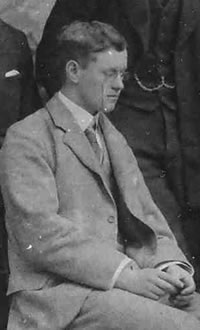 Reverend
A.P.Lacy-Hulbert
Reverend
A.P.Lacy-Hulbert